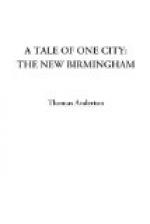It goes, of course, without saying that a business that has been carried on for over a century has seen great changes in regard to custom and customers. Consequently, it is not surprising to learn that wealthy iron-masters, the country gentry, and prosperous farmers no longer make the purchases of silver and fancy wares they did in the days that are no more. Black country magnates have discovered they can now do without many solid silver services, and even fairly well-to-do rural people find they can at a pinch put up with electro plate.
I confess I like to look at the bijou shop in High Street and think what it must have seen and heard in its time. It must have heard the bells of St. Martin’s toll for the death of Nelson and ring out joyous peals after Waterloo. It must have seen disorderly crowds march past its doors at the time of the Birmingham riots; more than this, it felt something of the lawlessness that prevailed, since the shop was looted and some of its contents carried off by the rioters.
Yes, as I have said, it must have heard some pealing and tolling of the St. Martin’s Church bells—and what charmingly mellifluous and melodious bells they are! I do not profess to be a campanologist or a bell hunter, but I have a loving ear for a sweet-toned church bell, and can think of few belfries whose contents surpass St. Martin’s, Birmingham. Although I have not heard the “Bells of Shandon” immortalised by Father Prout, I have, however, heard Great Tom of Lincoln. I have listened to the “bonny Christ Church bells” of Oxford, and my ears have dwelt upon the sweet jinglings of the Carrillion at Antwerp and in other Flemish cities. I have also heard the dulcet chimings of many village church bells in various parts of the land, and I have listened with undelight to the unmusical tones of Big Ben of Westminster, but so far as mellow tone is concerned, I rarely hear any ordinary church bells that are more dulcet and harmonious than the bells of St. Martin’s, Birmingham.
Few people heed their beauties I am afraid; indeed, some singularly insensible residents and traders in the neighbourhood have been known to protest against the charming chimings of the bells of St. Martin’s. Those, however, who want to hear the true musical quality and tone of these bells must select a quiet time, as the Bull Ring is not a particularly peaceful spot in the busy hours of day. Midnight is the witching hour that should be chosen to listen to the music of St. Martin’s belfry. It may be a late and inconvenient hour for the experiment, but it is worth it—if the bells still chime at that “ghostly” hour.
I am afraid I have indulged in a somewhat extensive parenthesis, but my pen has run away with me, and now it must come back to the old-fashioned High Street shop where I lingered a few paragraphs back. The adjoining premises to Mr. Pearsall’s, on the east side, are also old and well in years. They have been altered and provided with a modern “dickey”—I should say, front—which rather hides their antiquity. There is, however, still conspicuous a quaint and curious spout-head which bears the date 1687, showing that these premises have more than passed their bicentenary.




